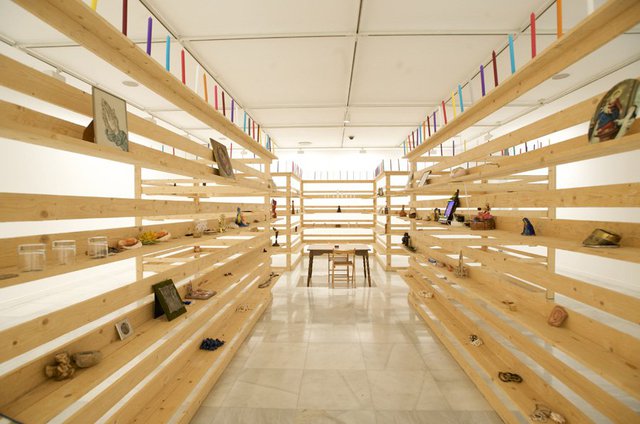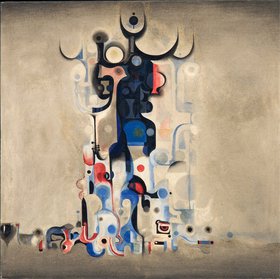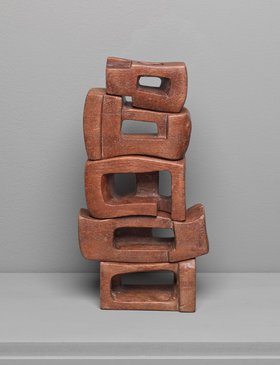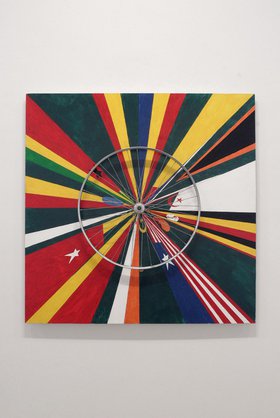Reviews
Re-Framing Modernism
Saloua Raouda Choucair, Ibrahim El-Salahi and Meschac Gaba at Tate Modern
An intriguing line of inquiry emerges from three exhibitions currently on show at Tate Modern. There is the exhibition of works by Saloua Raouda Choucair (born Beirut, 1918) showing to 16 October 2013, a retrospective of 'Visionary Modernist', Ibrahim El-Salahi (born Sudan, 1930) to 22 September 2013, and a presentation of Meschac Gaba's (born Benin, 1961) expansive, unfolding and ongoing installation known as The African Museum of Contemporary Art (showing to 22 September 2013), inaugurated in 1997 (and complete with online portal).
The spectrum is an acutely relevant one. It traverses the evolution of twentieth century modernism, from Choucair's distinctly continental aesthetics tempered by a grounding in the shades and shapes of Beirut, to El-Salahi's approach to a style that invokes Mondrian, albeit with a richer, more earthy, brush. Far from New York Boogie Woogie, El-Salahi's abstraction takes the same primary colours as Mondrian but claims them as the colours of his homeland, and warps them into beautiful, ornate shapes that appear ghostly, ephemeral and entirely autochthonous. El-Salahi's is an aesthetic formed from The Khartoum School. Yet it is a style also evocative of the Secessionists: of Vienna, Schiele, Kokoschka and the sooty, fleshy anguish of war, with figures that appear weathered, transcendent yet defiantly, at times even pathetically, human.
A series of works produced in the later part of the artist's career, presented in a room of works showing El-Salahi's Tree series (ongoing), presents a clear process of abstraction. Studies of trees give way to clean graphic lines reducing these natural forms into a series of grids that recall the same intellectual process of detraction that took place with Mondrian's own 'trees' (El-Salahi's 2003 canvas on which globular shapes perch on vertical red lines, The Tree, being a case in point). These are presented in a space preceded by a room of the artist's black and white figurative works produced after he was accused of anti-government activities in Sudan in 1975. Incarcerated for just over six months, El-Salahi settled in Qatar the same year he was jailed, and these stark, black and white works reflect on this experience (including Prison Notebook, 1976). Sharp and unforgiving, the images are fraught with tension: a subjective view of conflict and exile, all contained in El-Salahi's wrought and oft-interconnected bodies.
Aesthetically, the emotional intensity of El-Salahi's work is in opposition to Choucair's architectural models, sculptures and canvases depicting interlocking forms characterised by 'earthy curves and fine lines hinting at how [these forms] slot together.'[1] Choucair's approach to structure engages with the highest ideals of modernist thinking. (She was a fan of Le Corbusier and two photographs included in the exhibition are from a trip Choucair made to Le Corbusier's Cité Radieuse, with the artist's detailed notes scribbled on the back of each image). Many of Choucair's mostly unrealised architectural designs were envisioned as buildings or public sculptures, and there is a distinct romantic awe towards 'heroic modernism' in them.[2] This includes the wonderful, modular and intellectually playful maqete for apartment blocks rendered in a Tufa stone, Infinite Structure (1963-5), imbibed with a certain kind of interactivity caused by the constant mediation of similarity and difference in the work's interlocking forms.
Co-curator of the exhibition, Jessica Morgan, views Choucair's as a scientific practice. One that, as Kirsten Scheid notes, uses 'geometric forms and contrasting curves to set up a centrifugal rhythm.'[3] The result is a sense of 'perfect equilibrium achieved by continual movement' in which 'undeniably reminiscent forms appear to draw together, while their contrastive rhythm and colour seem to repel them apart.'[4]Yet, where these works seem emotionally tempered, especially in comparison to the work of El-Salahi, they are also contextualised by the specificty of Choucair's place and time. This is somewhat intensified further when considering Choucair's architectural models as reflections of both unrealised projects and unattainable aspirations: her gender made it impossible to practice as an architect. Some of her canvases in the exhibition bear the marks of the bombings that took place during the Lebanese Civil War: shells her apartment took as she worked in Beirut during the eighties. Perhaps this is why Choucair's daughter, who helped organise this exhibition, once described her mother's 'dual' works as embodiments of the Sufi principle to end all dualisms.[5]
This is where Choucair's work complements El-Salahi's, in that both oeuvres are humanist; each piece embodying clear – and arguably 'modern' – intentions. While Choucair concerns herself with the framing of social representation and engagement in her design work, El-Salahi explores the subjective and emotional depths of the human subject as framed by experience. And between these two exhibitions lies Meschac Gaba's Contemporary Museum of African Art, a work that proposes an entirely different kind of framing. Gaba's is a working installation: a literal museum of contemporary art that is at once modern in form, yet postmodern in its pastiche. The work critiques the very infrastructure within which art (and history) is given value by simulating it, simultaneously revealing the oft-masked colonial (and neoliberal) intentions of the museum space. Its critique is all-encompassing, from religion to the financial markets, expressed in the presentation of currency as geological artifacts or archeological discoveries, to a shrine made up of various religious symbols: the Virgin Mary and catholic prayer beads being two examples. There is also an interactive space called 'The Salon', where chairs are covered in a dollar bill pattern, and a 'Museum Shop', in which jewellery is made out of tightly scrolled banknotes. In Gaba's 'museum', we find a postmodern representation, in which the institutional (and modern) framework of culture – the museum – becomes the object. It is a view aligned with what Frederic Jameson might call the reading of modernity (and in Gaba's case modernity's imposition on African culture and history) as an object rather than an explanatory feature.[6]
As Okwui Enwezor writes on the project, Gaba's 'ambivalence toward investing the Museum of Contemporary African Art with a defining authoritative voice perhaps derives from his suspicion of the museum as grand narrative, as hegemonic totality.'[7] This kind of totality is, as many have observed, an inherently modernist ideal, and yet it comes with a view to mediate (or regulate) 'diverse structures and articulations of difference.'[8] Gaba reveals the shortcomings of presenting culture within an institutional, modernist frame, by reproducing its form and, in many ways, turning it inside out.
In this context, Gaba's exhibition acts as a counterpoint to the Tate Modern's move to present El-Salahi, Choucair and Gaba in tandem. There is a clear attempt across all three shows to, borrowing the words of Chris Dercon: '...call into question our one-sided Western concept of modernity.'[9] The result is a subtle drive to objectivity: each show is individual and isolated from the other and the museum has avoided any kind of linkage so as to repel any accusation of a modernist totalitarian, even imperial, re-framing. In the end, what Tate Modern has presented is simply the example of three artists from different generations engaging with the processes of modernity and modernism from different parts of the world and at different points in time.
Nevertheless, there is an undeniable sense of recovery going on. An attempt by a western global institution of modern and contemporary art to re-address twentieth century art movements within a twenty-first century global remit. And though one might say this kind of re-writing is itself a modern project, it is, nonetheless, an expansion of modernity and its legacies from a global perspective, as co-curator of El-Salahi's exhibition Professor Salah M. Hassan notes in El-Salahi's exhibition catalogue. Read together, these three shows veer from the canonical linearity of western art history and explore how modernism and its affects have been represented outside of the west. The result is a rewinding and reframing that views modernity as a larger, unfinished project.[10]
[1] Kaelen Wilson-Goldie describes Choucair's downtown Beirut public sculpture, Bench (1998) this way in 'Two Lovers in a Park on a Hot Day: The Urban Imagination of Saloua Raouda Choucair' in Saloua Raouda Choucair, ed. Jessica Morgan, Tate Publishing, London, 2013, p. 154.
[2] Jessica Morgan, 'Introduction', in Saloua Raouda Choucair, ed. Jessica Morgan, Tate Publishing, London, 2013, pp.13-14.
[3] Kristen Scheid, 'Distinctions that Could be Drawn: Choucair's Paris and Beirut', in Saloua Raouda Choucair, ed. Jessica Morgan, Tate Publishing, London, 2013, p. 52.
[4] Ibid.
[5] Kaelen Wilson-Goldie, 'Two Lovers in a Park on a Hot Day: The Urban Imagination of Saloua Raouda Choucair' in Saloua Raouda Choucair, ed. Jessica Morgan, Tate Publishing, London, 2013, p. 160.
[6] Frederic Jameson, A Singular Modernity, London, Verso, 2012, 33.
[7] Okwui Enwezor, 'The Death of the African Archive and the Birth of the Museum: Considering Meschac Gaba's Museum of Contemporary African Art', in Meschac Gaba, Museum of Contemporary Art, ed. Kerryn Greenberg, Tate Publishing, London, 2013, p.30.









